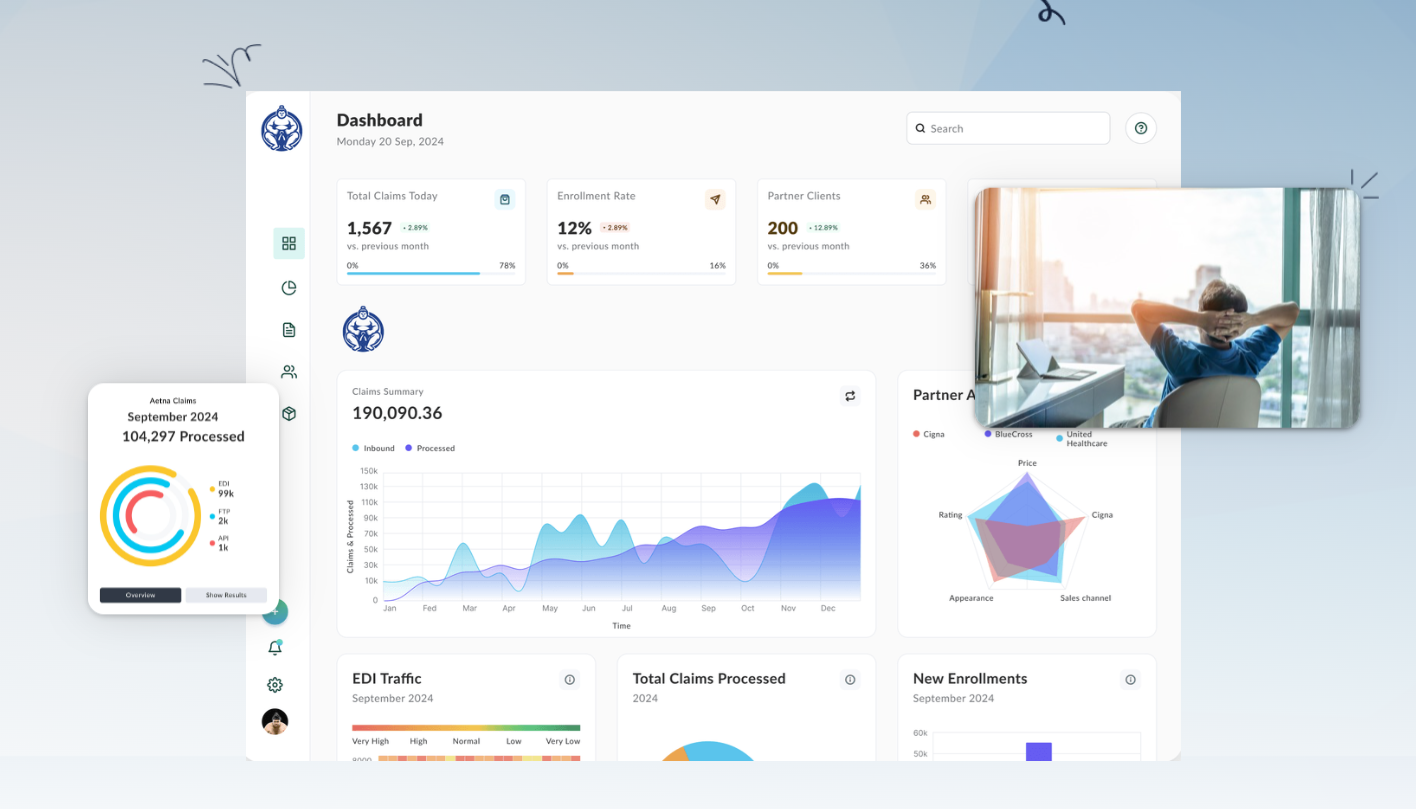Healthcare EDI Made Clear: 834s, 837s, Compliance, and Integration


Health insurance depends on the smooth, standardized flow of information between payers, providers, and administrators. At the center of that flow is EDI (Electronic Data Interchange)—the set of technologies and processes that make it possible to exchange sensitive data securely and at scale. For new payers, or for those modernizing legacy systems, understanding how EDI transactions work, and how to keep them compliant and integrated, is essential.
Why EDI Matters in Health Insurance
Regulatory requirements, tight turnaround times, competitive pressures, and a constant stream of enrollment and claims data mean payers succeed or fail by how well they manage EDI. Done right, EDI delivers consistency, auditability, and compliance—from first enrollments through complex claims adjudications—helping insurers and their partners work faster and with fewer errors.
EDI 834: The Foundation of Enrollment Data
The EDI 834 is the industry standard for Benefit Enrollment and Maintenance. This transaction provides the structure for employers, government organizations, or other sponsors to transmit membership and coverage changes to payers and plan administrators. The 834 format defines how add, change, or terminate records must be sent so systems downstream (like membership databases or claims engines) receive updates in real time and without error.
- Main Use: Transmitting enrollment, terminations, reinstatements, changes, and COBRA events.
- Core Challenge: Sponsors often send files in multiple, non-standard formats (CSV, XML, proprietary), requiring significant mapping and validation to reconcile with payer systems.
- Industry Need: Automated solutions that normalize all sources, flag discrepancies, and track every update for compliance and SLA obligations.
At EDI Sumo, we've seen organizations struggle with the patchwork of enrollment file formats. Our platform empowers payers by standardizing enrollment data from any source and providing real-time error detection and workflows for resolving conflicts—well before they can disrupt member coverage.
What Are SNIP Levels?
When talking about EDI in health insurance, you can’t ignore SNIP (Strategic National Implementation Process) levels. These were created by WEDI (the Workgroup for Electronic Data Interchange), a nonprofit that advises HHS and helps set industry standards for HIPAA and healthcare data exchange. SNIP levels define how thoroughly an EDI transaction is validated:
- Level 1: Syntax integrity — making sure the file is structured correctly, with proper segments, delimiters, and data types.
- Level 2: HIPAA implementation guide requirements — checking that mandatory fields are present and code values are valid.
- Levels 3–7: Advanced checks such as balancing edits, patient relationship logic, code set validations, duplicate detection, and payer-specific business rules.
For payers and providers, the difference between Level 1/2 and deeper levels is critical. At the lower levels, you’re only confirming that the file can be read and that the required fields exist. By contrast, higher SNIP levels test whether the data is accurate, logical, and ready to move through business processes without causing problems.
In practical terms, deeper SNIP validation reduces the chances of downstream errors—like rejected claims, mismatched eligibility records, or costly manual rework. Many platforms stop at Level 1 or 2, but reaching Level 7, especially for claims and eligibility transactions, dramatically improves first-pass rates and lowers audit risk.
EDI Sumo supports WEDI/SNIP Levels 1-7 for claims data, helping organizations address errors at the source and improve first-pass rates on claims submissions.
EDI 999 vs. 277: Key Differences
Understanding responses in the EDI cycle is critical for compliance, auditability, and fast resolution of data issues. Two commonly confused transactions are the EDI 999 and the EDI 277:
- EDI 999 (Acknowledgment): Used to confirm receipt and basic syntactic validation of EDI transactions, most commonly enrollment (834) or claims (837) files. It signals that the file arrived, and whether it passed or failed initial checks (not business logic).
- EDI 277 (Claim Status Response): Provides detailed claim status feedback. After a payer receives a claim (837), the 277 report gives specifics about acceptance, errors, rejections, or ongoing adjudication status.
For payers, automating the review of these transactions means errors and rejections aren’t missed on a manual spreadsheet somewhere—but are tracked, alerted, and resolved in real time. Our clients have avoided significant SLA penalties by identifying file issues right away, thanks to instant alerts and clear dashboards that surface failed transactions for immediate attention.
EDI 837 Claims Transactions
The EDI 837 is the dominant format for transmitting healthcare claim information from providers to payers. Processing thousands or millions of 837 files per month demands not just speed but precise compliance and error detection:
- 837 files contain detailed patient, provider, service, charge, and diagnosis code information.
- Accurate and timely processing is necessary to avoid claims backlogs, regulatory penalties, and unhappy members or providers.
- Automated error checking and real-time claims monitoring can flag issues (such as missing policy numbers, mismatched diagnosis, or duplicate claims) before they cause rejections or payment delays.
Payers and their IT teams are under constant pressure to do more with less. Relying on manual reviews or limited validation puts organizations at risk for audit findings, increased costs, and competitive disadvantage.
The Role of Compliance and Real-Time Monitoring
Staying compliant isn’t just about passing audits—it’s about building trust and preventing catastrophic data errors or breaches. Health insurance EDI processes are governed by HIPAA, requiring auditable logs, defined access controls, and robust data privacy measures.
- Audit Trails: Every interaction, file interchange, and user update should be tracked and reportable—especially during regulatory audits.
- Real-Time Monitoring: Live dashboards and SLA tracking ensure no transaction gets stuck, missed, or delayed. Automated alerts mean the team can proactively resolve errors before they impact members.
As leaders in the space, we put a premium on transparency and compliance. That means providing audit-ready reporting, data encryption, and stringent user controls as a standard—helping our clients pass audits with confidence and quickly investigate any compliance event.

Connecting EDI to Your Core Systems Without Hassle
The real challenge isn’t just translating EDI standards, but embedding these workflows seamlessly into your unique environment—whether you use legacy mainframes, modern SaaS claims engines, or a mix of both. The ability to integrate clean, validated EDI data with your claims management, enrollment, and CRM platforms is what bridges the gap between regulatory compliance and operational excellence.
- Multi-format support: Files come in all shapes—CSV, XML, proprietary layouts. Standardizing them reduces IT burdens and stops manual rework.
- APIs and automation: Real-time access (not batch) is critical for support teams and partners who need instant answers about a member or claim.
- Simplified user access: Not everyone is an EDI specialist. Modern solutions should empower business and customer service teams with intuitive dashboards and self-service tools, reducing reliance on scarce IT resources.
With EDI Sumo, payers can build a centralized hub for their EDI operations—processing, monitoring, and integrating enrollment, eligibility, and claims transactions with minimal IT overhead.
Simplify Healthcare EDI with Confidence
Spreadsheets, inconsistent formats, and missed SLAs don’t have to be the norm. With the right platform, payers can turn EDI from a constant source of friction into a competitive advantage—reducing risk, cutting costs, and giving teams the visibility they need.
EDI Sumo was built for payers who want to manage enrollment, eligibility, and claims with less IT overhead and more control. Schedule a demo today to see how you can streamline compliance, accelerate claims, and transform the way your organization handles EDI.


.png)





.png)

.png)


.png)
